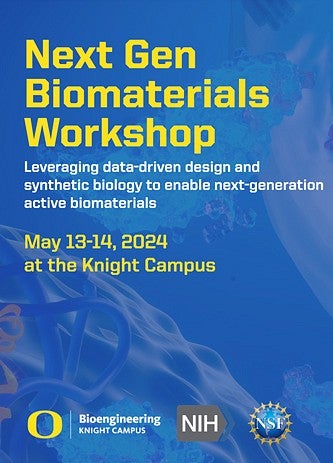The Department of Bioengineering at the Phil and Penny Knight Campus for Accelerating Scientific Impact hosted a two-day Next Generation Biomaterials workshop on May 13-14, 2024. Developed in collaboration with the UO’s Department of Chemistry and Biochemistry and the Materials Science Institute, the symposium welcomed 48 preeminent scholars, including thought leaders from industry, academics, national labs, and scientific publishing.
“We’re excited to host some of the top polymer scientists, chemists, bioengineers, and biologists in their fields to envision how the next generation of biomaterials will meet the growing demand for rationally designed materials and translate discoveries for advances in human health,” said Danielle Benoit, Lorry Lokey Chair of the Department of Bioengineering and one of four lead organizers of the workshop.
A biomaterial is a material engineered to interact with biological systems for a medical purpose. Some of the potential applications for the next generation of biomaterials that were the focus of the May workshop included tissue engineering, integrative biology, and drug delivery. The workshop provided a forum to highlight and explore the recent developments in the field and facilitated the development of a multidisciplinary plan to bridge the divide from research to clinical translation.

The workshop addressed a major gap that exists in converting advances in biomaterials science to feasible approaches tailored toward pressing biomedical problems. It focused on four integrated “science drivers” that are critical to the development and translation of next generation biomaterials, with each area led by a UO researcher:
Synthetic biology-enabled biomaterials — Marian Hettiaratchi, assistant professor, Department of Bioengineering
Smart/responsive biomaterials — Mike Pluth, professor, Department of Chemistry and Biochemistry
Biofabrication and biointerfaces — Ramesh Jasti, professor, Department of Chemistry and Biochemistry
Data-driven methods for biomaterials design — Danielle Benoit, Chair of the Department of Bioengineering

In addition to offering a forum to share some of the exciting advances in biomaterials with an eye toward the future, the workshop also provided opportunities for several UO graduate students, postdocs and trainees to participate via a poster session and support facilitation of conference breakout sessions.
The findings of the workshop will be shared with the public and the scientific community through publication of a white paper and a review article. Organizers are committed to broadening the scope of applications of translational biomaterials to match the diversity of patient populations and participants, especially from historically marginalized groups, to drive creative and unique approaches.
This workshop was funded through a new collaboration between the National Science Foundation's Division of Materials Research (DMR) and the National Institute of Biomedical Imaging and Bioengineering (NIBIB).
"These workshops are specifically designed to catalyze innovation at the intersection of materials science and biomedical research to explore new biomedically-relevant active materials,” said Shadi Mamaghani, program director with the Division of Materials Research at the National Science Foundation. “We aim to address the crucial transition from discovery to development, ensuring medical applicability.”
The symposium was organized by a committee of facilitators and co-PIs representing the Knight Campus Department of Bioengineering, the UO Department of Chemistry and Biochemistry and the UO Materials Science Institute.
"By bringing together the experts in active matter biomaterials, we foster dialogue and collaboration, driving breakthroughs in healthcare. This will inform the two federal agencies on the topical areas where collaborative efforts are necessary,” said Germano S. Iannacchione, division director of the Division of Materials Research at the National Science Foundation. “By working together alongside the scientific community, we lay the foundation for the future of biomedical technologies."
For more information, visit the Next Generation Biomaterials website.

